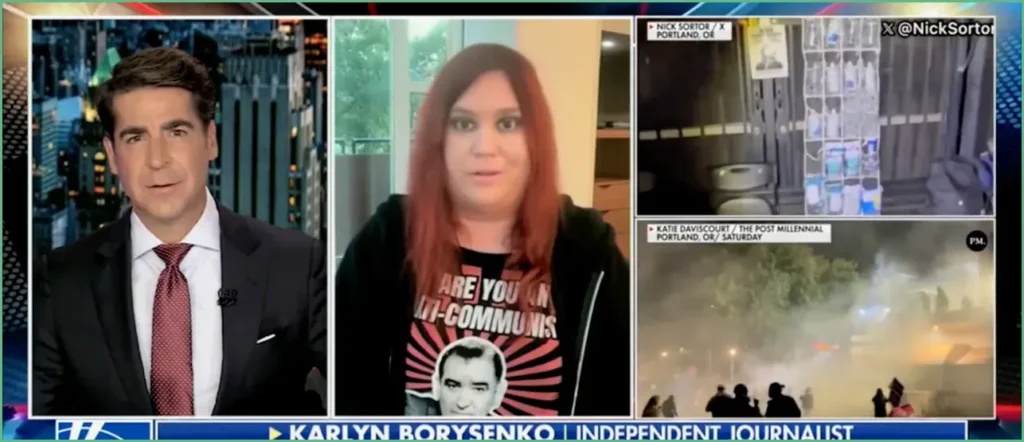Independent journalist Karlyn Borysenko stunned Jesse Watters on his show by naming the ordinary jobs many Antifa activists hold, arguing these militants aren’t all homeless radicals but teachers, lawyers, baristas and other salaried workers who funnel money into sustained, violent street operations. The exchange raises sharp questions about who funds and enables persistent unrest in cities and whether the institutions that employ these people should be held to account. This piece covers the interview moments, the examples Borysenko shared from her reporting, and the political fallout from designating Antifa a terrorist group.
Karlyn Borysenko’s appearance on Jesse Watters’ program didn’t feel like a soft conversation. Watters pushed the basic question: do these people have normal lives, or do they just “dance and light fires all night” in service of chaos. The blunt line of questioning put the spotlight on a simple fact politicians and pundits often ignore: many who agitate in the streets also show up at work the next morning.
const observer = new MutationObserver((mutations) => { const adDivToHide = document.querySelector(“#dailycaller_incontent_1”); if (adDivToHide && dc_noads_page) { adDivToHide.classList.add(“hide-premium”, “hide-free”); observer.disconnect(); console.log(“Ad div found and hidden”); } }); observer.observe(document.body, { childList: true, subtree: true });
Borysenko answered with on-the-ground reporting that landed like a punch. “I think some of them do actually have jobs. I mean, these are teachers, some of them are lawyers, some of them, you know, they’re Starbucks baristas, they’re Amazon employees. So, I don’t necessarily agree with the notion that they don’t work,” she said, laying out that membership in violent street movements is not the same as down-on-their-luck desperation. That point shifts the debate from mere sympathy to accountability.
She explained how those paychecks turn into fuel for the movement’s infrastructure. “That’s actually part of how they fund all the supplies in those tents is through something called mutual aid, where they take their salaries and they’re donating to those supplies,” Borysenko added. “But certainly, there are some that are kind of out there 24/7.” Her reporting suggests a mix of full-time activists and everyday workers who bankroll and sustain a network of protest logistics.
const observer2 = new MutationObserver((mutations) => { const adDivToHide2 = document.querySelector(“#dailycaller_incontent_2”); if (adDivToHide2 && dc_noads_page) { adDivToHide2.classList.add(“hide-premium”, “hide-free”); observer2.disconnect(); console.log(“Ad div2 found and hidden”); } }); observer2.observe(document.body, { childList: true, subtree: true });
Watters pressed for specifics, asking whether there are educators who spend their days in classrooms and their nights attacking property. Borysenko didn’t hedge. “Oh, yeah, 100%. I was just undercover at a couple of anarchist book fairs over the weekend in both San Francisco and Seattle,” Borysenko responded. “There were absolutely teachers in the crowd there. And I picked up multiple stickers and posters with Molotov cocktails, calls to kill ICE and calls to kill the police.”
!function(r,u,m,b,l,e){r._Rumble=b,r[b]||(r[b]=function(){(r[b]._=r[b]._||[]).push(arguments);if(r[b]._.length==1){l=u.createElement(m),e=u.getElementsByTagName(m)[0],l.async=1,l.src=”https://rumble.com/embedJS/u3rtroj”+(arguments[1].video?’.’+arguments[1].video:”)+”/?url=”+encodeURIComponent(location.href)+”&args=”+encodeURIComponent(JSON.stringify([].slice.apply(arguments))),e.parentNode.insertBefore(l,e)}})}(window, document, “script”, “Rumble”);
Rumble(“play”, {“video”:”v6ykbgo”,”div”:”rumble_v6ykbgo”});
The reality Borysenko describes complicates the standard narrative that violent street groups are marginal and disconnected from civic life. When teachers, lawyers and corporate employees are implicated in calls for violence and the distribution of incendiary material, the question becomes whether employers and community leaders should respond. Conservatives argue that institutions must enforce standards of conduct and face consequences for employees who cross legal lines.
const observer3 = new MutationObserver((mutations) => { const adDivToHide3 = document.querySelector(“#dailycaller_incontent_3”); if (adDivToHide3 && dc_noads_page) { adDivToHide3.classList.add(“hide-premium”, “hide-free”); observer3.disconnect(); console.log(“Ad div found and hidden”); } }); observer3.observe(document.body, { childList: true, subtree: true });
The political response has already landed. President Donald Trump announced the designation of Antifa as a terrorist organization and called for probes into who is bankrolling the network. From a Republican vantage, that designation is overdue because it acknowledges a pattern: chronic unrest backed by organized financial support and active, named participants who live seemingly normal lives.
Antifa’s rise to national attention began long before the most recent flare-ups, but the 2020 riots made the network a household term. That period showed how street movements can reshape city life and test the resolve of local governments and law enforcement. The debate today isn’t just about ideology; it’s about public safety, transparency and whether citizens will tolerate a class of militants who hide behind professions while funding and staging violence.
What Borysenko’s reporting makes clear is that the problem is not hypothetical or abstract. It is a practical, solvable issue if communities choose to demand responsibility and enforce laws evenly. Republicans push for investigations, prosecution where appropriate, and accountability from employers who may be allowing or unknowingly funding radical behavior through employee contributions or workplace culture.
